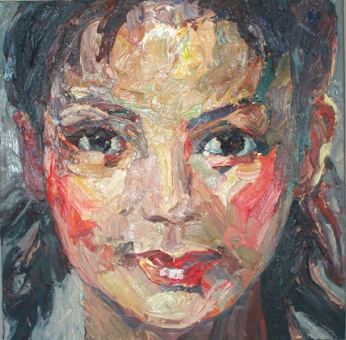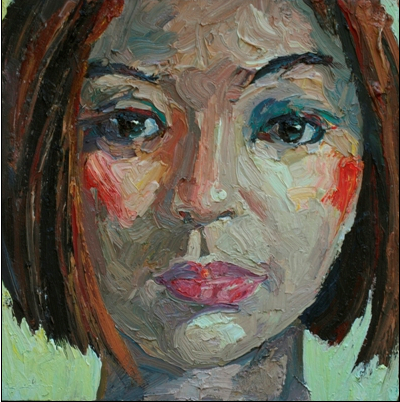8-15-09
China in Motion: Jian Wang’s Fresh Strokes
By Diane Sippl

Beijing Girl #31 Oil on Canvas 30" x 30 " 2009
A “Beijing Girl” is never at rest. Patches of pigment dance across her face, swelling and bursting from its surface in a buttery lather you could spread for miles. Each swath bends its own band of hues; each meddle makes its own light. Bold strokes volley across the bones, over the flesh, jostling and tossing with each other. Her cheeks and lips are aflame, and her eyes won’t let you go. A “Beijing Girl” is a commotion — of color and texture teeming with life.
Eleven new “Beijing Girls” are
currently on offer at Dawson Cole Fine Art in
In the huge new bilingual, hardcover, 160-page volume, Contemporary Work: Jian Wang also available at the gallery, Gu Yue, Doctor of the Academy of Arts and Design at Tsinghua University in China, notes that Jian Wang’s brushstrokes are like “the lines of a controlled and refined personal calligraphy, elegantly understated and supremely confident.” At the same time, he observes that Wang lives and works “with a kind of inspired, improvisational passion.”
The early “Beijing Girls”
appeared in Wang’s 2007-08 series of very large works called New Modern Urban Girls in reference to
youths who posed for their portraits when Wang set up his studio in
Beijing Girl #39 Oil on Canvas 24" x 48 " 2009
Work and Art
“These girls working in the
service sector,” Wang explained at the Dawson Cole Fine Art gallery, “along
with men working in construction, have made
“I asked myself what to paint
when I went to
At the same time, much of the vitality of the “Beijing Girl” paintings stems from the artist himself. One of Wang’s past mentors, Wayne Thiebaud, vividly characterizes the “risk” Wang invests in his work:
“Direct application, bravura thrusts, going for it, realizing it can collapse at any moment, means he has to make lots and lots of paintings… because they are always on the edge…. This thrust and physicality is what makes the paintings seem alive, like they are almost still being created.”
“Each of my paintings is 90% experiment and
10% experience. Because of this, it
doesn’t work every time,” Wang told those of us attending Dawson Cole Fine
Arts’ opening reception for Fresh Strokes
in
Beijing Girl #40 Oil on Canvas 24" x 48 " 2009
Weaver of Colors
Wang considers his approach both emotional and physical. “I usually use only three brushes, big ones — house and furniture painting brushes, one to two inches wide, because I use the sides, too, depending on how I twist the brush. I begin with just eight colors, combining them right on the canvas. This is intuitive. I’m careful with my gestures. As I work, many colors begin to infuse each stroke. They are never completely mixed, so they are quite alive.” It’s this technique, and not the rich oil of the paint that seems never to dry, that creates an unforgettable radiance in the paintings. Their light is that dynamic play of color in each stroke, all but sculpted on the canvas, casting shadows in its depth.
Responding to the Expressionists in the San Francisco Bay area (Manuel Neri, Richard Diebenkorn, Joan Brown, Elmer Bischoff), Wang further side-steps the use of sketches, base colors, and palettes, adapting the “premier coup” or alla-prima (“first stroke”) approach to apply raw color with fast and forceful brushwork that reveals its speed and dynamism on the canvas. The pigment is not layered but stacked, allowing Wang to carve into the thick and heavy impasto the lines that give birth to a shape, or the strokes that reflect light. There he weaves his colors, his crisscrossing movement of the brush, his rising and falling textures. The painting is never “finished”; rather, it is an ongoing enactment of the creative process. And that process continues in the eye of the beholder.
The noticeable fact that all of these painterly values fluctuate as the point of view shifts on the “Beijing Girls” only accentuates their liveliness. Viewed in detail, their abstraction increases as lathery swirls pulse with color contrasts beside jagged mounds of paint. Yet at a distance the faces become starkly real, fusing color and form into a singular expression with radiant emotion. Regardless of the monumental size of most “Beijing Girls,” they cast an intimate lure to the spectator via a charm that transpires within the paintings and emanates from them with the change of perspective. As “close-ups,” their composition catches us peering at them, until we become self-conscious of our point of view as the faces look back.
The paintings, in and of themselves, are about looking — not only about how we gaze with curiosity at these youthful protégés of China’s globalization, but also about how they look at us — their very process of registering and taking in a new and vastly different world, changing by the moment, that they might make their own. The speed at which they do this today is reflected in the artist’s process in creating their images.
That self-reflexivity within the
painting as an artistic medium possesses Wang himself, who in 2006, just prior
to his return to Beijing, commented to Jessie Qu (in Jian Wang: The Legend of a Chinese Artist in the United States), “I
found that Minimalism relies heavily on the deletion of reality, and it bears a
close relation to our time. Gradually
its pure nature infused a sense of loss and a feeling of desire in me.” That sense of loss and desire took Jian Wang
home to
Self-Portrait #3 Oil on Canvas 30" x 30 " 2009
“Break Up Your Palette”
Having mastered both poster-style
realism (he was luckily recruited to paint placards as a youth during his
“re-education” amidst China’s Cultural Revolution) and also traditional Chinese
calligraphy (he managed to teach it to an association of college students at
Dalian Railway Institute where he studied and taught engineering), Wang wanted to leave
these behind when he moved to the U.S. in 1986. His goal was to continue his private
childhood investigations of Michelangelo and Rembrandt and become well versed
in various languages of European oil painting — Impressionism, Abstract
Expressionism, and Minimalism. As he
studied and practiced these near
Based in Sacramento for twenty years and studying there as well as at UC Davis (he earned a Bachelor’s and a Master’s in
Art), he painted hundreds of striking landscapes of the American River across
the seasons and times of day as well as full-figure nudes and still life works,
many of watermelons. With his bright and
massive colors, he was painting directly opposite his subject, like his Bay
Area peers; and like his predecessors in the
“Your colors and brush strokes
are too stiff… Be brave — animate your paintings,” Wayne Thiebaud, his mentor
at the

Beijing Girl #48 Oil on Canvas 30" x 30 " 2009
Red Means Life
Expressionistic in his application of pigments and Impressionistic in his segmentation and juxtaposition of colors, Jian Wang intuitively shifts the outlines of his forms with the swift motion of his brush. With the long and short, free and fluid, but vigorous and precise strokes of a calligrapher, he captures the mettle of his female subjects, an exterior/interior coming into being. Girls from the countryside whose cheeks bear the mark of sleeping over warm bricks — girls in uniform who personalize their looks by painting their own cheeks with rouge — they are girls in motion, making the moves themselves. Consciously or not, Wang’s pronounced use of red evokes the traditional values of Chinese culture: red for joy, for passion, for life.
“The girls in my paintings can’t quite support their families on what they make in the city and send home,” Wang observes. “In fact, often in rural areas, the family values and practices are still a bit feudal. They want boys to be born so that they can carry on the family name and count on strong labor in the fields, because the labor is still not always mechanized, or not totally. Communism and the Cultural Revolution did help women legally and politically — what they have said is true: ‘Women hold up half of heaven’ — but Westernization is their liberation now, because it gives the girls a new sense of independence, an identity, at least. When you walk into a karaoke house or a big restaurant, ten or twenty girls are lined up to welcome you…. I want to do a bronze sculpture with twenty girls all in a line, called, ‘Welcome’. But in sculpture I’m still too much like Rodin. I haven’t found my own voice yet….”
Wang in
In her article on a film by China’s world-lauded director, Zhang Yimou, “Not One Less: The Fable of a Migration,” Rey Chow discusses how we look at Wei, a teenage girl recruited as a teacher in the impoverished Shuiquan Village of northern China, as she travels to a nearby big city to look for one of her students who fled there for work to help his sick mother. Rey Chow proposes that our way of looking at Wei is not transparent, that simply seeing her doesn’t allow us to understand who she is, what she thinks, or how she feels, as we might suppose. In fact, Chow claims, “Sight… is a surveillance mechanism installed on (other) human beings…” yet what we see might not be what we get. Furthermore, there might be a better way of looking than from the mere angle of information retrieval for the “factographic value” of an image.
This sounds grim, but it’s only to say that the actual means of representing and of seeing are important, as much in everyday life as in artworks such as films or paintings. Wang is the first to point out our traditional images of Chinese women and the pervasive media constructs. Put another way, he has remarked, most instructively,
“What matters is how I paint, not what — my fingerprints as an artist. Hopefully viewers can look past my work as descriptive and see it instead as pure play among the compositional elements of my paintings.”
Does this mean that who he paints is insignificant? Not at all. But it means that we might look at his painted subjects with the same eyes with which we gaze at his self-portraits. Not all of our questions will be the same, but they might overlap. And when we ask why he paints the way he does (considering his thousand canvases sold already and up to fifty “Beijing Girls”), we might discover a new way of seeing.
Images are not illustrations, nor interpretations of a narrative such as migration or globalization, much less answers or explanations. Wang’s dynamic response to contemporary life takes shape in the semiotic movement traceable in his handling of visuality. He enters into a dialogue with the shifting cultural identities of his subjects through the lens of his own fluctuating cultural experience as an artist with ever-evolving modes of expression.
“A poet is a kind of unsettled soul, always on the drift. Often it retires itself from the body and looks back on itself from a remote horizon. It is usually in the distance that a poet finds his true self and true life, a place he can never reach.”
Xu Jiang, Preface
Jian Wang: The Legend of a Chinese Artist in
the
FRESH STROKES: Recent Paintings
by Jian Wang
Gallery Director (888) 972-5543